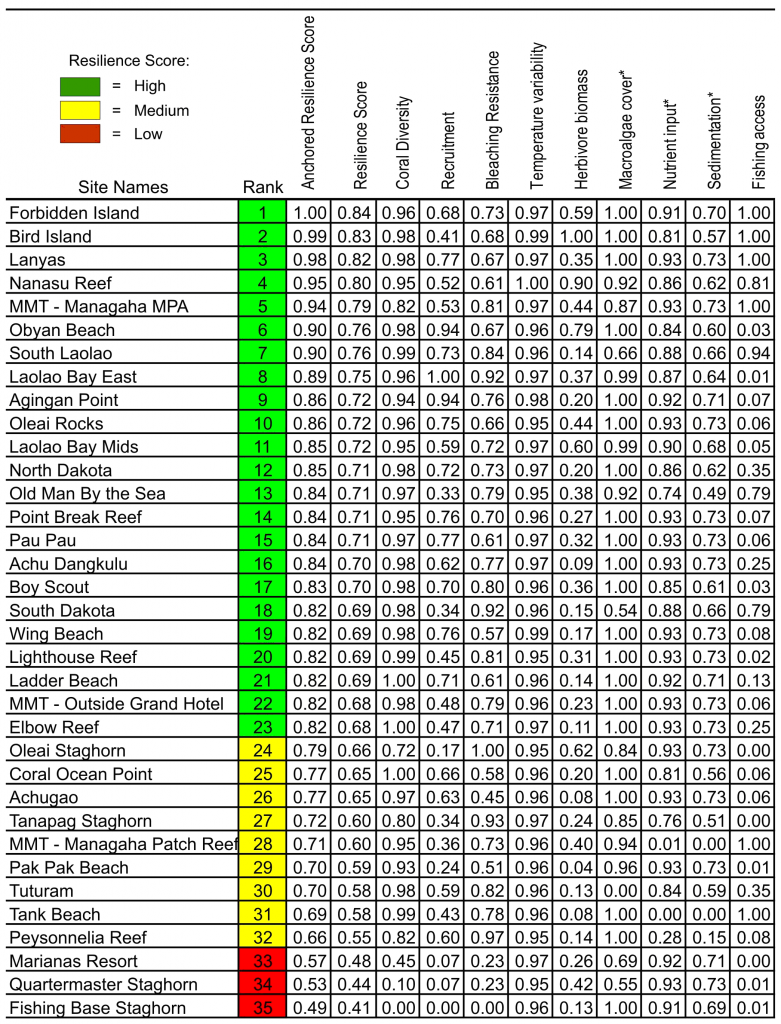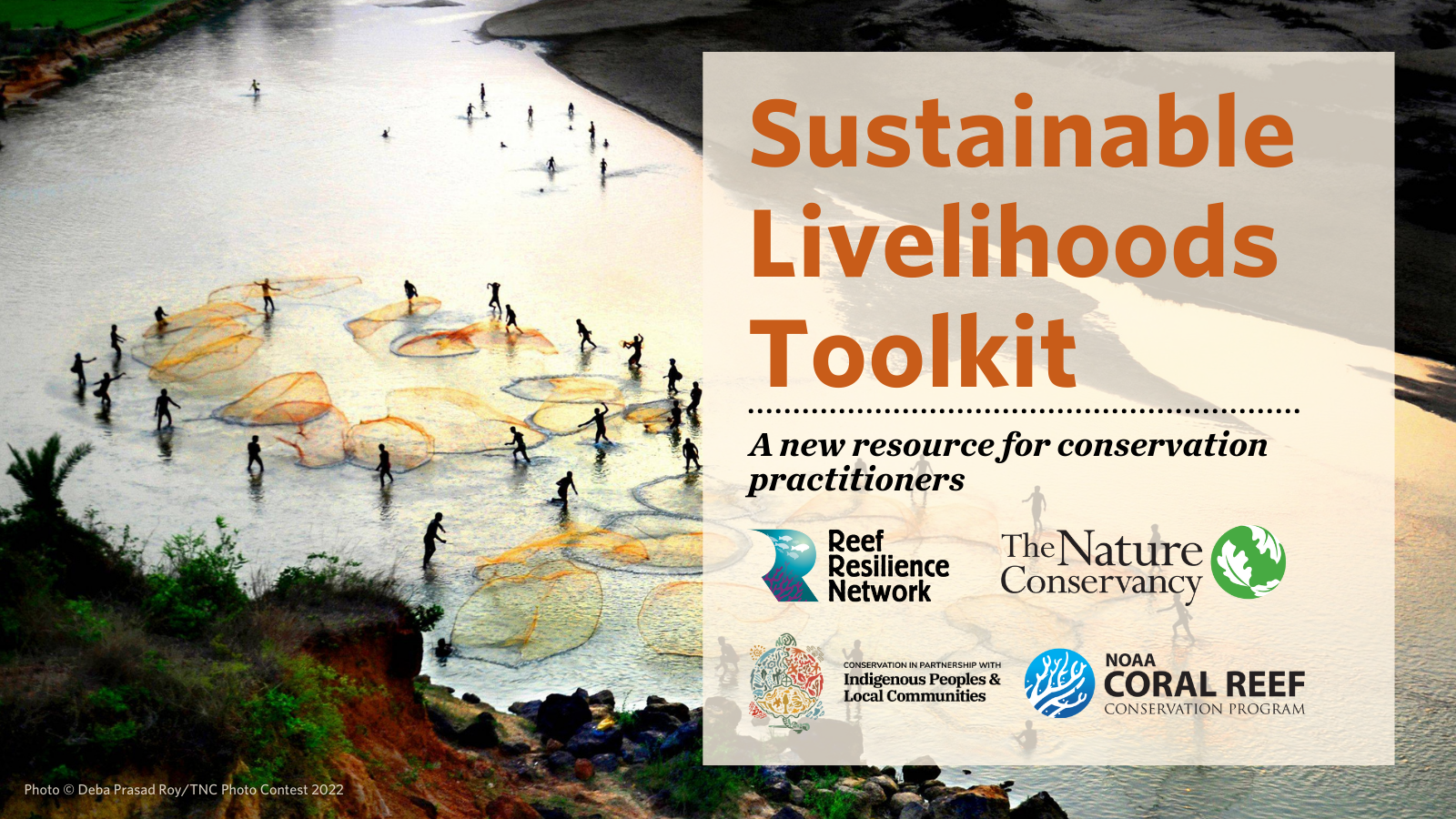Field-based Assessments of Coral Reef Resilience to Climate Change in Saipan, Commonwealth of the Northern Mariana Islands
Location
Saipan, Commonwealth of the Northern Mariana Islands (CNMI)
The challenge
Coral reefs worldwide are threatened by a combination of global and local stressors. In the Commonwealth of the Northern Mariana Islands (CNMI), managers are working together to address these threats and to assess the resilience of coral reefs. Identifying sites with high resilience potential can inform a range of management decisions to support and maintain the natural resilience of coral reefs. Many have been working to develop frameworks that enable reef resilience to be assessed and compared among sites. In the months before this fieldwork, a framework was published that suggests 11 variables (or ‘resilience indicators’) be evaluated to compare the resilience potential of coral reef sites. These are: coral diversity, bleaching resistance, recruitment, herbivore biomass, macroalgae cover, temperature variability, nutrient input, sedimentation, fishing access, coral disease, and anthropogenic physical impacts (McClanahan et al. 2012). This case study describes the first field-based implementation of the McClanahan et al. (2012) framework in Saipan, CNMI.
Actions taken
Methods
The 11 resilience indicators were measured or assessed at a total of 35 sites around the island of Saipan in May and June of 2012. Details on the methods used can be found here. To calculate a relative resilience score, the following method was used. The value for each indicator for each site was expressed as a percentage relative to the maximum value for that indicator among all sites. This practice is called ‘anchoring’ and normalizes the data to a standard scale of 0-1 (the percentages are expressed as decimals). The resilience scores calculated are the average of the scores for the 9 indicators included in the analysis (the variables above minus coral disease and anthropogenic physical impacts, which were not observed), and the sites were ranked from highest to lowest resilience score. The relative categories high, medium and low were used to describe the scores for all indicators and for the resultant resilience scores.
Results
23 sites were found to have high relative resilience; 9 sites have medium, and 3 have low (see Table 1 below). Principal Components Analysis revealed that rankings were most strongly driven by coral diversity, bleaching resistance and macroalgae cover. Without exception, sites with the highest resilience, relative to other sites surveyed, have high coral diversity, high bleaching resistance and low macroalgae cover. Low coral diversity, low bleaching resistance, and high or at least medium macroalgae cover characterize low resilience sites. High and medium resilience sites are located throughout all of Saipan’s reef habitats while the low resilience sites are all in the Saipan lagoon.
Table 1. Final resilience scores and rankings for the survey sites. Anchored (to the max value) and normalized (uni-directional 0-1 scale) scores for all 9 variables are shown to the right. Resilience scores are the average scores for all variables, then anchored to the highest resilience score (column right of rank). High relative resilience potential includes the range (0.8-1.0), medium (0.6-0.79), and low (<0.6).

How successful has it been?
Based on the resilience analysis, the project team made a number of suggestions to coral reef and coastal managers working in CNMI:
- For management actions that result in benefits that take many years or decades to manifest – like marine protected areas – we suggest that sites with higher relative resilience potential deserve greater consideration. Further, we suggest reducing anthropogenic stressors to the extent possible at the sites assessed as having the highest resilience potential.
- Sites with greater coral diversity and low macroalgae cover deserve special consideration from managers as these may be high tourism value sites.
- Actions resulting in improved water quality on reefs will affect the resilience potential of the greatest number of sites (versus other actions).
- Protecting herbivorous fish populations is especially important at locations with greater relative vulnerability to coral bleaching.
Sites were identified that met the following conditions: high resilience, greater coral diversity, low macroalgae cover, or were more vulnerable to coral bleaching, or some combination of those. All of the various suggestions made have resulted in action by local natural resource agencies in CNMI. Actions include: communication and outreach, updating management plans, re-assessing water quality treatment, and strengthening partnerships with tourism operators. The agencies tasked with allocating conservation and management resources and effort around Saipan are also responsible for other reef areas within CNMI. For that reason, the project team will soon extend the analysis and work to include reef sites near Tinian and Rota, which have lower levels of anthropogenic stress.
Lessons learned and recommendations
Collecting all of the data required to undertake a resilience assessment is a resource-intensive exercise and requires many people with different types of expertise. Using existing datasets is strongly recommended to reduce the cost of the assessment. In many coral reef locations, multiple agencies and groups will benefit from the analysis results and outputs so cost-sharing is possible and should be explored.
Including many agencies and perspectives can increase buy-in and maximize uptake but may mean it will not be possible for everyone to be entirely satisfied with the final methods. Assessing spatial variation in exposure to anthropogenic stressors can be especially controversial, so the final approaches used for anthropogenic stressors need to be developed transparently and collaboratively.
Assessing the relative resilience of reef sites generates information that can be used to make resilience-based management decisions; i.e., decisions resulting in the targeting or tailoring of management actions to support the natural resilience of coral reefs. Completing the assessment is not an endpoint in itself, and the capacity to conduct an assessment is not reason enough to undertake the assessment. It is critical to consider first how the assessment results and outputs will be used. A list of information needs is included on the Assessing and Monitoring Reef Resilience page. An assessment may be justified when it meets one or more of those needs.
Funding summary
The Western Pacific Coral Reef Institute and the University of Guam supported parts of the project as did the CNMI Coral Reef Initiative, which had a grant from NOAA’s Coral Reef Conservation Program and Senator Gregorio Kilili Sablan.
Lead organizations
NOAA Fisheries
CNMI Division of Environmental Quality
The Nature Conservancy
Pacific Marine Resources Institute
Partners
University of Guam
Western Pacific Coral Reef Institute
NOAA Coral Reef Conservation Program
CNMI Coastal Resources Management
CNMI Division of Fish and Wildlife
Resources
Assessing and Monitoring Reef Resilience
Selecting Resilience Indicators
US Virgin Islands Resilience Assessment Case Study
How-to Guide for Conducting Resilience Assessments
Prioritizing Key Resilience Indicators to Support Coral Reef Management in a Changing Climate
Operationalizing Resilience for Adaptive Coral Reef Management Under Global Environmental Change


